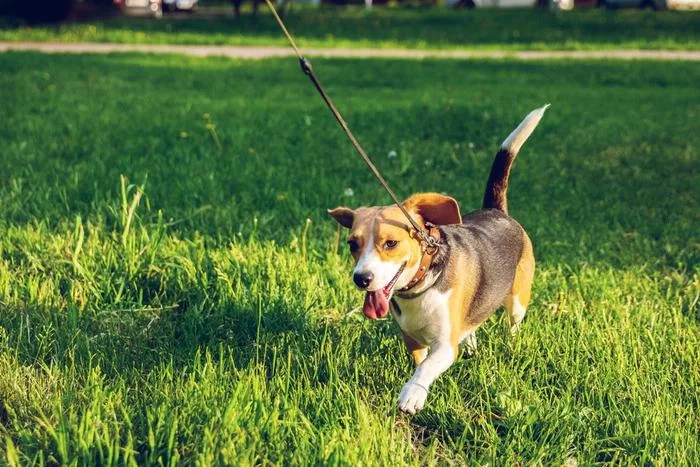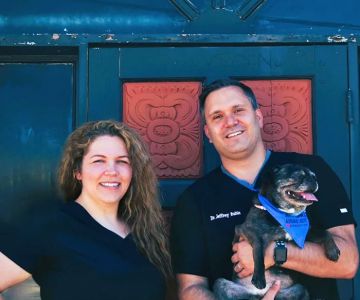- Why Leash Training is Important for Your Dog
- Getting Started with Leash Training
- Step-by-Step Guide to Training Your Dog to Walk on a Leash
- Common Challenges and How to Overcome Them
- Additional Tips for Successful Leash Training
- When to Seek Professional Help for Leash Training
1. Why Leash Training is Important for Your Dog
Leash training is one of the most essential skills you can teach your dog. Not only does it provide safety during walks, but it also helps establish a sense of control and improves your dog’s behavior. Without leash training, your dog may pull, become easily distracted, or even run into dangerous situations. Proper leash training ensures that both you and your dog have an enjoyable and stress-free walking experience.
At Hidden Brook Veterinary, we understand the importance of good leash training, which is why we offer expert advice and support for dog owners. A well-trained dog on a leash is easier to control, and walking becomes a positive activity for both you and your furry companion.
2. Getting Started with Leash Training
Before beginning leash training, it's essential to choose the right equipment. A comfortable collar or harness and a sturdy leash are key components. Many dogs, especially puppies, may not be used to wearing a collar or harness, so it's a good idea to allow them to get accustomed to the gear before beginning training. Try to fit the collar or harness snugly, but not too tight, to ensure comfort during the walk.
Once your dog is comfortable with their collar or harness, it's time to introduce them to the leash. Keep the first few sessions short and simple. Let your dog explore the leash in a safe and confined area before heading outside for a walk.
3. Step-by-Step Guide to Training Your Dog to Walk on a Leash
Leash training requires patience, consistency, and positive reinforcement. Here’s a step-by-step guide to training your dog to walk on a leash:
- Start Indoors: Begin the training process inside where there are fewer distractions. Attach the leash to your dog’s collar or harness and encourage them to walk with you around the room. Reward them with treats when they walk by your side.
- Short Walks Outside: Once your dog has gotten the hang of walking indoors, take them outside. Keep the walks short at first, gradually increasing the length as they improve. Always reward your dog with praise and treats when they walk calmly on the leash.
- Correct Pulling: If your dog begins to pull on the leash, stop walking immediately. Wait until they stop pulling and come back to your side before continuing the walk. This teaches them that pulling will not get them anywhere.
- Use Positive Reinforcement: Consistently reward your dog with treats or praise when they follow the rules. Positive reinforcement is key to helping your dog learn what behaviors are acceptable while walking on the leash.
Consistency is key—ensure that you are repeating these steps every time you walk your dog, and gradually increase the difficulty level by adding more distractions as they get better at walking on the leash.
4. Common Challenges and How to Overcome Them
Leash training is not always smooth sailing, and there are a few common challenges that dog owners face. Here are some solutions to the most frequent problems:
- Pulling: If your dog pulls excessively on the leash, try using a front-clip harness to reduce pulling. Stop walking whenever they pull, and resume only when they are calm.
- Fear or Anxiety: Some dogs may feel nervous or anxious when first using a leash. Start by desensitizing them to the leash and collar before attempting walks. Gradually increase their exposure to the outside environment, and use calming treats to reassure them.
- Distractions: If your dog becomes easily distracted by other animals, people, or objects, try walking in less busy areas at first. Gradually introduce them to more stimulating environments as they become more focused during walks.
5. Additional Tips for Successful Leash Training
To ensure success in leash training, here are a few additional tips:
- Be patient: Leash training can take time. Dogs learn at their own pace, so avoid getting frustrated if progress seems slow.
- Stay consistent: Consistency is essential in leash training. Always use the same commands and reinforce positive behaviors.
- Keep training sessions short: Dogs have limited attention spans, so keep training sessions brief and engaging to avoid overwhelming them.
- Use appropriate walking equipment: Choose a harness or leash that is suited to your dog’s breed and size. Some dogs may do better with a harness, while others may need a standard collar.
6. When to Seek Professional Help for Leash Training
If you’re struggling with leash training or your dog exhibits aggressive or unmanageable behavior, it might be time to consult a professional dog trainer. Trainers can provide expert guidance and create a personalized plan to address your dog’s specific needs. At Hidden Brook Veterinary, we recommend consulting a professional if your dog’s behavior continues to be challenging despite your efforts.
Training your dog to walk on a leash is a rewarding experience that can greatly enhance your relationship with your pet. With the right approach, patience, and consistency, you can teach your dog how to walk calmly and safely on a leash, making every walk an enjoyable experience for both of you.












